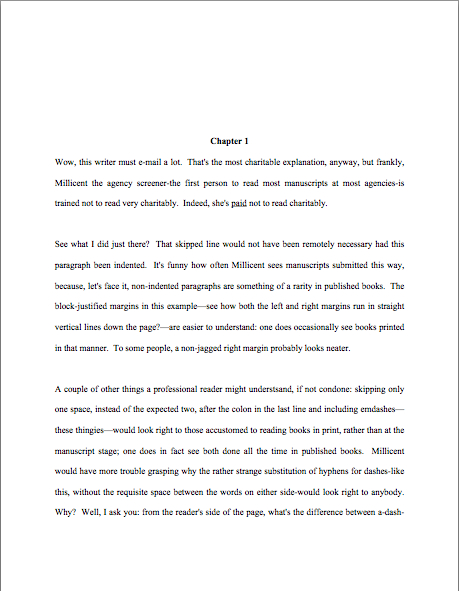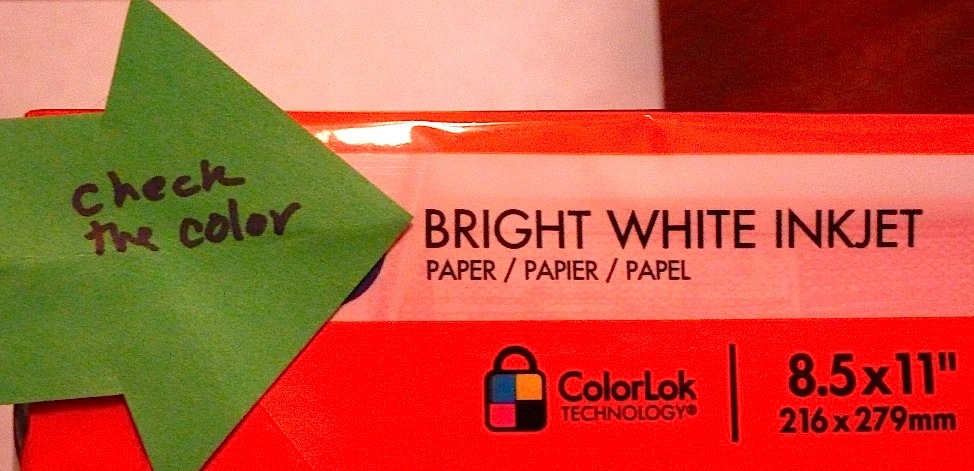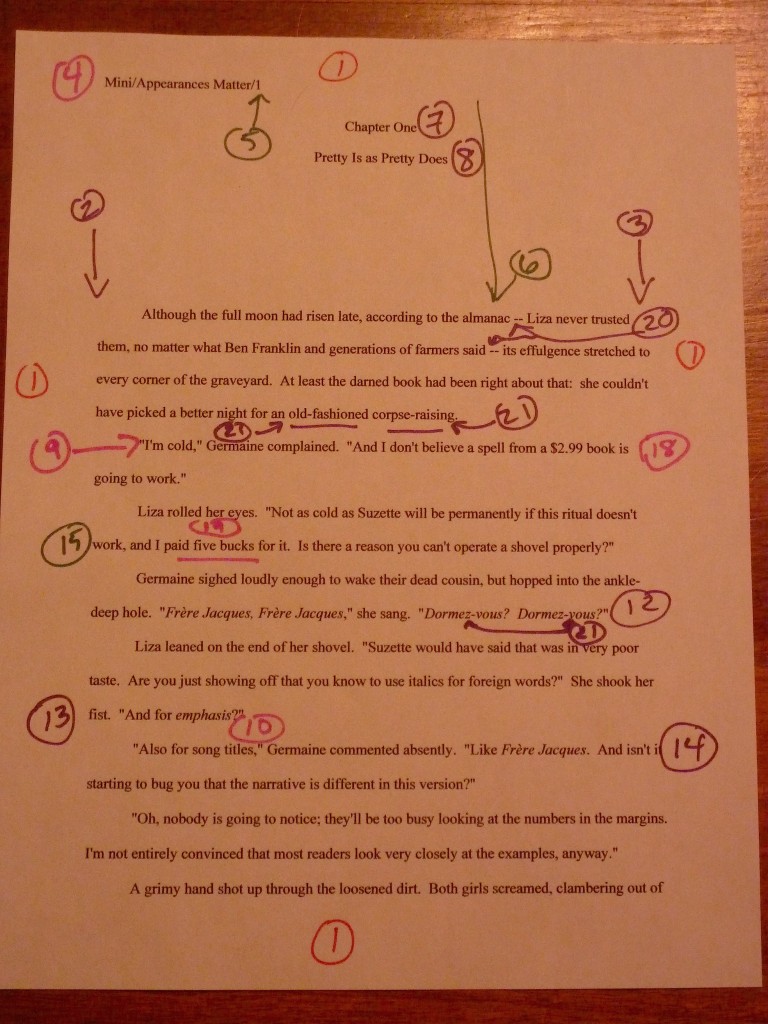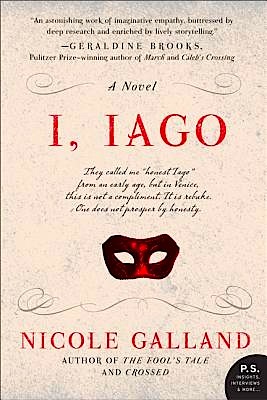No time for a long-winded missive today, campers, but I could not let the occasion pass without posting a few words. What occasion rises to the mandatory observation level, you may well ask, eyeing both the lapse between this and my last post and the undeniable fact that Author! Author!’s older posts are still, alas, unhappily plagued with extraneous symbols? Participating in a species of conversation all too common behind the scenes in publishing circles.
It tends to run something like this: someone whose job it is to read submissions, all day, every day (except, of course, on those days she invests in skimming a few hundred queries at a sitting) quietly goes nuts while reading the 531rst submission of the month. Grounding her no doubt expensively straightened teeth to an extent that her former orthodontist would deplore, our Millicent — for yes, it is she, everybody’s favorite agency screener — she vents her frustration upon a sympathetic friend while she is waiting in line for her latté.
“It’s happened again,” she murmurs into her phone. “Three submissions in a row in which the text asserted that what was going on was…wait for it…just like something in a movie!”
Having been savvy enough to call a fellow professional reader, she’s sure to meet with sympathy. Calling me, however, might not have been the best choice. “I know, I know: it’s maddening to see writers rush to use the same metaphor, over and over again. But you must admit, it isn’t those three writers’ fault that you happened to read their submissions back to back.”
“Not their fault!” Predictably, Millicent burns her lip on her too-hot latt?. “Everybody knows that saying something happening on the page was just like a movie is bad writing.”
I can’t resist teasing her; we’ve had this discussion too many times. “It depends upon how the sentence using that tired old concept is constructed, doesn’t it? I could imagine it being expressed very prettily.”
“Fine. I’ll send the next fifteen manuscripts that use it to you, so you can compare their delightful sentence structure.”
She’s laughing by the time we hang up, but I must admit, she has a point. As anyone who reads for a living could tell you — particularly agents, editors, and the screeners they employ, all of whom by necessity must read manuscripts one after another, due to sheer volume — nothing quite makes the mind scream like spotting the same phrase, concept, or metaphor crop up repeatedly, page after page. When those pages happen to belong to different manuscripts, the frustration can be even greater: after the fourth or fifth time in a week, even the most literature-loving Millicent can start to wonder if half of the writers in the English-speaking world gathered someplace secret five months ago, to agree upon what the clich? of the season will be.
Hey, there are fashions in writing, just as in anything else that requires taste to appreciate. And, just as in runway fashion, once an innovative author hits the big time with a unique offering, the pros are used to seeing dozens — nay, hundreds — of copycat submissions flooding their inboxes shortly thereafter.
At first, that can be exciting: it’s no secret that publishers often attempt to capitalize upon the success of a bestseller by bringing out similar books in short order. Which makes sense, right? A certain group of readers have already demonstrated that they like that kind of book; why not offer them similar titles?
Actually, there’s a pretty good answer to that: after what can be an astonishingly short time, however, the readership for a particular type of story can, well, get tired of it. Perhaps more to the point for those trying to break into print, the Millicents tasked with screening all of those remarkably similar stories can begin to find them a bit predictable.
And those Millies are not the only ones. “Another Twilight knock-off?” their bosses exclaim. “This one had better have an awfully different spin.”
The rapid rise and fall of bestsellers and their followers is too well known in literary circles to raise many aspiring writers’ eyebrows these days. Come closer, though, and I’ll let you in on a little professional secret: that’s not the kind of repetition that causes Millicent to fling aside a submission, rend her garments, and rush out the door for a coffee refill. It’s seeing how many otherwise original, well-written manuscripts utilize precisely the same standard comparisons and hackneyed phrases as those that are neither prettily constructed nor particularly unique.
Seriously, it’s kind of startling to spot on the page. A pro will be reading along, enjoying a good story well told, when she’s abruptly confronted with a paragraph like this:
Ambrose staggered, stunned by the force of the blow. The world wavered before his eyes, as if he were watching an old movie and a flashback was just about to begin.
Nothing wrong with the writing there — so why might that last clause send Millicent’s hand automatically reaching for a form letter beginning Thank you so much for your submission, but I’m afraid it does not meet our needs at this time? Could it have anything to do with the fact that an hour ago, she had just rejected a manuscript containing this gem?
Mignonette clutched her head, trying to make sense of it all. It was surreal. She felt as if she was in a movie.
Leaving aside the relatively rare editorial pet peeve regarding how often narratives describe perfectly comprehensible scenes as surreal — not nearly so often as they label a situation utterly devoid of irony as ironic, admittedly, but still, frequently enough to become annoying — is it really so hard to understand why the lingering memory of Mignonette’s affection for film might color Millicent’s perception of the freshness of Ambrose’s reaction to the blow?
And a thousand writers’ hands shoot into the air. Yes? “This is ridiculous, Anne,” film aficionados everywhere grumble. “Why shouldn’t two writers embrace the same comparison, if they write about it differently? Feeling like you’re in a movie is a fairly common experience, after all; eschewing writing about it would be akin to declaring that depicting a character drinking milk an instant-rejection offense.”
An excellent argument, grumblers, but part of the problem is that so many manuscripts don’t write about it differently. Even in conversation, it was just like a movie is a clich? for a reason, after all: in everyday life, people tend to describe what you rightly point out is a common feeling in the modern world in a common way.
Correct me if I’m wrong, but isn’t one of the primary goals of developing an individual authorial voice not to express things precisely like everybody else does? And don’t we writers pride ourselves upon presenting our readers not merely with a mirror held up to their own lives, accompanied by a transcript of what they already hear, but our own personal take on reality, phrased in a way that is like no one else’s prose?
Do I sense writers of third-person fiction leaping to their collective feet, shouting, “Yes, by gum! Down with hackneyed phrases and concepts!” while those of you who spend your time crafting first-person narratives sat on your hands? I’m not entirely astonished: writers of first-person fiction and memoir frequently work under the principle that if good first-person narration reads as though an actual human being might conceivably have said it out loud, and if most people incorporate clich?s into their everyday speech, then loading a first-person narrative with clich?s is only being true to life, right?
Well, arguably. It can — and all too often does — result in a narrative voice that sounds not like a specific individual, but just anybody. Millicent is also confronted with this kind of opening many times a day:
Oh, my God, I can’t believe it. I’m sick of this. The gall of some people! I’m so over it. I’m out of here.
Believable verbal expression? Oh, yes. But I ask you: what do those stock phrases actually tell you about this narrator? Or about the situation, for that matter?
Hackneyed phrases and concepts are, after all, generic. That’s why polite exchanges so often bore readers: by definition, those phrases that everybody says in particular situations convey no individualized meaning.
Did I just hear some eyebrows hitting the ceiling? I kid you not: as delightful as courtesy is to encounter in real life, it can be stultifying on the page. Take a gander:
Kendrick held out his right hand. “Nice to meet you.”
“Pleased to meet you, too,” Ghislaine said. “Beautiful day, isn’t it?”
“Yes, the weather is nice. Oh, here’s Maurice. How are you, Maurice?”
They shook hands like old friends, as indeed they were. “Fine,” Maurice said. “How are you?”
“Oh, fine. Ghislaine, this is Maurice.”
Maurice shook her hand. “How are you?”
“Fine. How are you?”
Longing yet for death’s sweet embrace? What if you had read similar personality-free conversations eight or nine times today?
Does that prospect appall you? Or have you caught up pitchforks and torches for some other reason?
“Oh, come on, Anne,” polite people everywhere scoff, genteelly brandishing weaponry. “Everyone understands that these are stock phrases — but that’s the point, isn’t it? By having the characters spout courteous clich?s, the narrative is letting the reader know that these are nice people.”
Perhaps, but surely, that’s not the only way to demonstrate their many sterling qualities. If Kendrick complimented Ghislaine on her fetching frock, would he not come across as a pretty nice guy? If she were rushing back from her volunteer work with homeless children, pausing only briefly to exchange pleasantries before her shift at the leper colony began, might the reader not gain an inkling of her other-orientation? If Maurice had just experienced the loss of his beloved pet ocelot, would you consider her rude if he mentioned it?
Actually, that last one’s not the best example, as Millicent would hasten to tell you. She could not even begin to estimate how many times in any given week of screening her tired peepers fall on a scene like this:
“How are you?” Kendrick asked.
“Fine.” Maurice drew his sleeve across his eyes. “Except my beloved pet ocelot, Coriolanus, has just passed away.”
“I’m sorry for your loss,” Kendrick said. “Oh, here comes Ghislaine. Ghislaine, Coriolanus died!”
“Oh, Maurice!” she exclaimed. “I’m so sorry for your loss.”
I could go on and show what the policeman on the corner, all seventeen of Maurice’s coworkers, and his great-aunt said upon hearing the news, but you’re sensing a pattern, right? I’ve said it before, and I shall no doubt say it again: just because people say something in real life doesn’t mean that it will make good reading on the page.
Or, to put it another way: strong dialogue doesn’t need to sound like everyday speech to work in print. It’s needs to be more interesting than everyday speech.
If it’s to impress Millicent with its originality and beauty, that is. After hours of too-polite dialogue, imagine what a relief it could be to read an exchange like this:
Ghislaine realized that she knew the man tugging on her arm. “Why, Kendrick, you look just awful!”
“I feel as if my guts have been ripped out.” He managed a brave smile. “Haven’t you heard about Maurice’s ocelot?”
Her intestines squirmed with anticipated horror. “What’s happened to Coriolanus?”
“Killed in a freak basketball accident. He was prowling along the top of the backboard, and a rogue shot knocked him to the ground.”
“Oh, my God!” Ghislaine cried. “It’s just like something in a movie!”
Oh, so close! Millicent was just settling in for a nice, interesting read, and the manuscript had to throw up a red flag. It might not be the final red flag for this submission — you would want to find out why there’s an ocelot in this story, right? — but in most professional readers, Ghislaine’s cri de coeur would at least elicit a roll of the eyes.
Were there other problems on the page, though, it might well prompt a cry of “Next!” Remember, it’s Millicent’s job to thin the submission pile. Her boss, the agent of your dreams, can only take on a few new clients per year; naturally, there’s a heck of a lot of competition for those spots.
That being the case, is it truly sensible submission strategy to decorate your manuscript with that observation about how the ongoing situation resembles what one might expect to encounter on the big screen?
Do I hear some cries of despair out there in the ether? “There you go again,” frustrated writers complain, and who could blame you? “You’re just accepting Millicent’s claim that everybody knows that the movie comparison is bad writing. At the risk of repeating the grumble from earlier in this post, doesn’t it all depend upon the writing?”
Yes, of course — and no. You see, good writing doesn’t exist in a vacuum; readers of every stripe tend to read more than one author in their lifetimes. They have come to expect the work of one author to differ from every other’s.
And they’re right to expect that: imagine how boring life would be if all well-written books sounded as though they had all been written by the same person!
In an agency, publishing house, or even within the context of a writing competition, good writing doesn’t magically rise to the top of the submission or entry pile. To get to it, Millicent and her ilk read through everything else. Since a submitter cannot control the order in which his work is read, it really doesn’t make strategic sense to rely upon the hope that his use of the movie trope — or any other commonly-employed comparison or phrase — will not pass under a screener’s eyes immediately after somebody else’s attempt to do the same thing.
Even the best of literary devices can start to seem overused with repetition after all. Think about Millie’s screening day for a moment. What kind of pretty prose do you suppose greeted her over the morning’s first latté?
She ran through the bleak forest, her long, red hair streaming behind her. Were those dogs she heard in the distance? Why had Fidelio placed her in this horrible position?
No time to wonder — those villagers with torches would catch up with her any minute now. If she’d been the monster in a Frankenstein movie, she couldn’t have been in more danger.
Come on, admit it — you’re starting to tire of the film references. And although I’m certain it doesn’t feel that way, so far, only four of the examples in this post have contained it.
Yes, really. This comparison gets old fast.
Picture, then, how Millicent’s weary eye must twitch upon catching sight of yet another iteration of the same concept. Especially if the next manuscript in the pile read like this:
Silvia couldn’t believe it — this was all so surreal. She didn’t even feel like herself: it was like she was watching herself on television.
In response to what fully a quarter of you just thought: no, Virginia, referring to television instead of a movie wouldn’t lessen the negativity of Millicent’s reaction. She would merely think that the writer of that last one didn’t get out as often as the writer of the one before it.
She would have a hard time justifying sliding either page under her boss’ nose, and not just because, like any experienced professional reader, the agent for whom Millie works may safely be assumed to have seen the movie/television/music video comparison thousands of times already. Like many publishing professionals, that agent may also feel a certain resentment towards movies, television, music videos, and new media for taking up time that right-minded people used to devote to reading.
But it didn’t occur to our submitter to say that Silvia’s surreal experience was like something in a novel, did it?
Still not convinced? Okay, I’m dropping all pretense: there’s one other reason that Millicent might hesitate to overlook this particular red flag on the page. This next example is infected with a mild case of the phenomenon; see if you can spot it.
Ricardo ducked behind the nearest desk, gasping as if he were about to have a heart attack. What a great movie this chase would make! Except that no one would believe it.
Yes, this passage contains the dreaded movie comparison, but did you catch the secondary problem? Essentially, what a great movie this chase would make! is a review of the scene currently in progress: not only is the narrator telling the reader that this chase would be exciting on the big screen — the text goes so far as to say that the result would be great.
If Millicent and her kind cringe when they spot a hackneyed phrase or concept in a submission, they see red when they think a manuscript is indulging in self-review. “It’s not your job to tell me how great you are,” she’s likely to snap at the manuscript. “It’s your job to show me. And it’s my job to decide whether you’re great, good, or so-so.”
The moral here, should you care to know it: it’s a heck of a lot easier to impress a professional reader with good writing that’s original than good writing that strays into overused territory, either in terms of wording or concept. Stock phrases and comparisons might sound right in the privacy of your writing studio — as well they should: people actually do talk in clich?s. But by definition, clich?s are not fresh; clichés are not original.
And trust me on this one: that clich? about how the current scene is like a movie ceased causing agents and editors to exclaim, “Wow, I’ve never seen that on the page before!” approximately two and a half years into the silent era.
Maybe it’s time to give it a rest. Instead, why not startle and delight Millicent with an insight and phrasing only you could have produced?
It’s worth a try, anyway. Keep up the good work!






















































